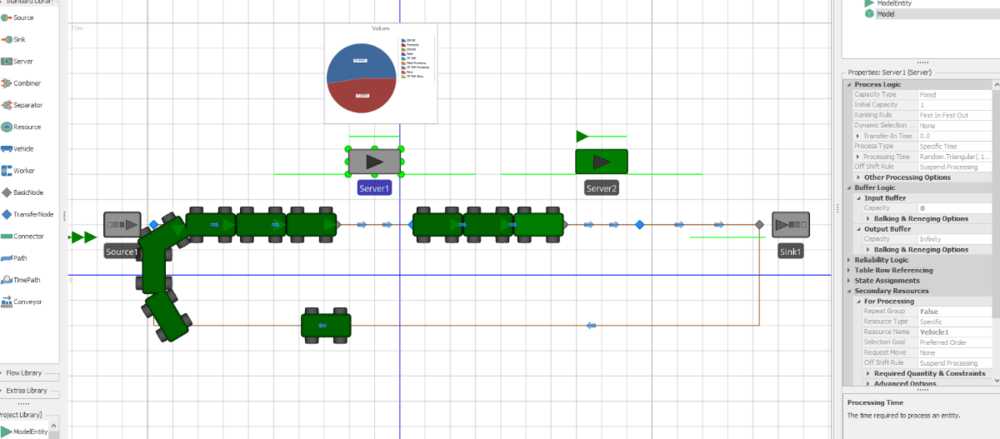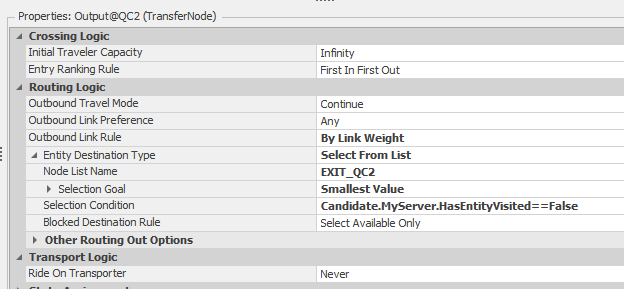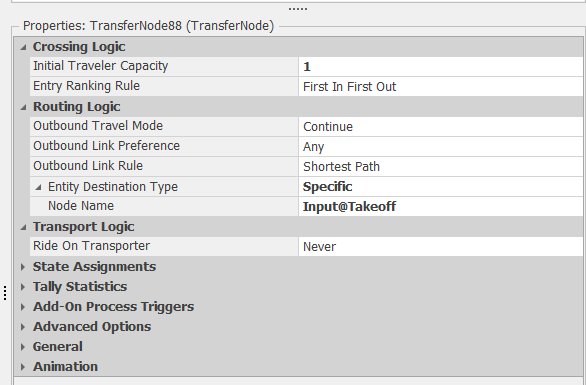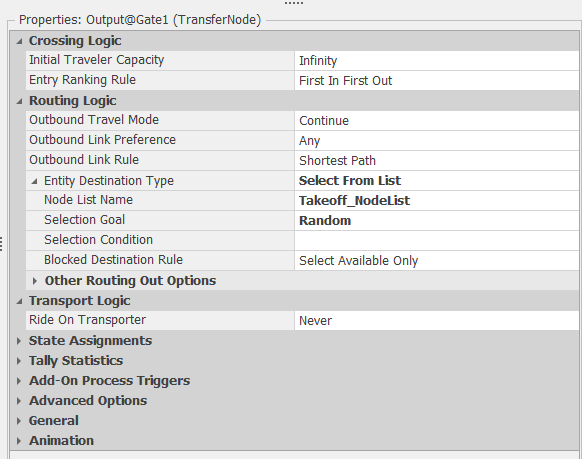Search the Community
Showing results for 'selection weight path'.
-

Assigning workers to specific servers by work day
dsturrock replied to esimiouser's topic in SI General Discussions
If you haven't already done so, I'd start by reviewing the SimBit ResourceSelectionConcepts. It contains several models that explain different types of resource selection. In particular, I'd suggest a combination of the following approaches: Create a table for each Worker (and/or each Server) where columns in the table represent the constraint or exclusions. For example, you might have a server table with columns for each day, and each column might contain a list of workers who can potentially be used on that day. Use resource lists to select from. possibly with exclusion conditions (maybe referring back to a table) of which resources cannot be used on that server and that day. -
You want to make the servers have a Capacity Type of Schedule and follow the default Standard Week. If you don't want to give them a lunch break, just change the definition of the Standard Day. Leave the default Off Shift Rule of Suspend Processing. The easiest approach for arrivals is to have a Source with an Interarrival time of 4.33 weeks (or 4 weeks) and an integer random distribution for the Entities Per Arrival. Doing a "first Monday" is possible, but a bit complicated because Simio time does not have the concept of Month because months are of varying size. You could probably specify the initial Time Offset to be early in a month, then maybe make the interarrival time be something like DateTime.DaysInMonth(DateTime.Month(Timenow),DateTime.Year(TimeNow)) which would make the next arrival be exactly one month later (same day of the month). When you say you have no buffers, what do you mean? If an entity arrives when all servers are busy, should it be balked (possibly disposed) or should it wait somewhere like on the server input node, on a path or in the Source output node? If the above arrival approach isn't exact enough, you can put exact arrivals in a data table. The arrival time could be specified at any exact datetime you desire and still have the Entities Per Arrival be a distribution.
- 2 replies
-
- server
- work schedules
-
(and 2 more)
Tagged with:
-
This light-weight add-in is for importing experiment from .csv file. In order to use that, just unzip the attachment and put the ImportExperiment.dll under the UserExtensions folder of your Simio. For those who want to check the source code, the whole solution is also inside the zip file. This add-in reads control values from you input file and creates scenarios. You can either create a new experiment for your model, or append scenarios to your existing experiment. The number of columns of your .csv file should be the same as the number of controls of your model. For example, if your model has three controls: NumDoctor, NumNurse, NumRoom, then running the add-in with the following input file will give you an experiment with 5 scenarios input.csv: 3, 3, 2 2, 3, 2 1, 3, 1 2, 2, 1 3, 1, 1 ImportExperiment.zip
- 1 reply
-
- 1
-

-
I'm making a call center simio model. The 7 types of calls are generated at sources and then move down a path to a server. This server represents a queue that is formed at the call center. After the queue server the calls are transferred to 1 of 7 desks (which are represented by a server) where a call agent is working. How do I make it so the calls do not go to one of the server desks until a desk becomes available. As it currently stands the calls go right through the queue server and build up at some desks even if there are free desks available.
-
Hello, I am writing my master thesis on production system design with simulation modeling. I have designed two models in Simio - one for current production system and one for optimized one. They are both designed in a correct way and they work as they are supposed to. The only difference between them is in path lengths. The difference between results from optimized and current system should be 3 - 5 % but for some reason I get all of the results identical to the last decimal place after running an experiment. I have attached a picture of my path properites and travel logic of entities. My guess is that for some reason path length is not being considered in the simulation. If anybody has any ideas what could be wrong, i would really appreciate your help.
-
Happy new year! One thing that I noticed is that with this model, the server never have a state of "blocked". I increased the processing time of Server2 and added a status pie to Server1. The server 1 is either Processing or starved, but never blocked according to the pie. But it should be blocked part of the time since I increased the processing time of Server2 to force this. It looks like the Server1 only accepts a new item to process if the path between Server1 and Server2 has room for at least one more vehicle. So the time that it should be blocked is considered as part of the "Starved" instead. I tried to figure out why this happens without success. Anyone knows why this happens? I attach the model to the post. Thank you! Input Server1 not blocked.spfx
-
Hi everyone, I am trying to model entities moving from 10 origins (sources) to 10 destinations (sinks). The entities are simultaneously created according to a certain mix (Entity1 (85%), Entity2 (10%), and Entity3 (5%). However, the number of entities created per event is according to a certain distribution. There is an OD-matrix that captures the number of entities moving from origin to a specific destination. Let's say there are 10 destinations, than the destinations of the Entities are determined according to the OD-matrix: Entity1 and Entity2 can move to any of of the sinks. Entity3 can only move to one specific sink. One solution I came up with was to add weights to Connectors and assign destinations using TransferNodes, but I think that this is very inefficient. I then started to work with DataTables, but I cannot figure out how to probabilistically assign the destinations of the entities. My question is: how to model the probabilistic destination assignment of Entities using DataTables in such a way that it is relatively easy and flexible to add or remove Sources/Sinks? I have added the model for you to see, I hope that you can help me! Many thanks in advance Simple_OD_creation.spfx
-
Hi there, I'm very much a novice, but currently leveraging the logic in VisitAllServersInAnyOrder simbit to ensure an entity visits an entity is never reworked more than once. I've updated the model entity with required state variables and created a "MyServer" to create the "HasEntityVisited" etc etc. I'm using the "Candidate.MyServer.HasEntityVisited==False" logic for the selection condition in the output node routing logic. However, whenever I run the model I get the error message "Referenced definition type "MyServer" does not match executing type "BasicNode". I've gone over and over the various elements and compared to the working simbit, but can't identify the issue. Any help would be greatly appreciated. Thanks in advance. Garrett
-
How can I use the TableName.PropertyName.RandomRow function in these two situations? 1. If the column of the weights (PropertyName) is determined during the simulation. 2. If I don't want all the rows to be taken into account. For example, only the rows that meet a condition based on other columns in the table. Given Table1 as in the following figure : StringProperty# columns are the filters and RealProperty# columns the weights used for function Random.Row. So, for situation : 1. I want to select one of the RealProperty# columns during the simulation but if I do that I can not use RandomRow because I need to write down the column name (PropertyName). Any suggestions for that? 2. I only want to use the weights that are associated between the rows that have A and X in the first two columns and that, therefore, the selected row is between one of those. Thank you in advance.
-
Hello River, I downloaded your files. The Gate512 was missing. I removed the information in the "30 Departure.xlxs" file that I can run the model ;-). Generally I understood how it works. Answer to your first question: I think you mean these two ways, right? From the left and from the right. In this case I saw that you used the "Routing Logic" in like all Transfernodes. The Outbound Link Rule is "Shortest Path" and you set the "Node Name" to "Input@Takeoff" Simio is using everytime the shortest link path now. Like in the screenshot below: In my opinion it would be better to set the destination once after the Entity got created in the Source for example :-). There are different ways to do that. In your model I removed all Routing Logic in the Transfernodes and used the Routing Logic only in the Output-TransferNodes of the Sources. In Simio you need only to use one time a SetNode-Step or a Routing-Logic to set the destination of an Entitiy and Simio will follow the paths or travel in the FreeSpace. You can use for example a NodeList with 2 different destinations and this Routing-Logic: With the "Selection Goal" Random Simio will randomly choose the destination from the NodeList. I uploaded you your model with the changes as an example: Problem on the taxiway version 17A.zip What did I changed? 1) I removed the Routing Logic in all TransferNodes. 2) I added new Routing Logic to the TransferNodes of the Output-Node of the Sources. 3) I added a NodeList with 2 new Nodes. 4) In the two new Nodes I used a Nodes-Entered-Process and a Transfer-Step to transfer the Entity to the Input of the Sink. Answer to your second question: You can change the destination of an Entity any time. In the Path (Link) you have a function called "NumberTravelors" for example to get the number of travelors currently on this path. So you can use a Expression like "Path123.NumberTravelors < 2". This can be used to decide if a way is full allready that the other way get selected. Or you can use a Integer-State and count up and down. I would use a Node-Entered-Process in the last possible node with a Decide-Step and two SetNode-Step in this case :-). I hope my answer will help you. When you have any other question, you are welcome! Best regards Pascal
-
Hi I've got a model where the situation is like this: 1. 3 Worker: W1 W2 W3 2. 3 Server: S1 S2 S3 On Monday (work schedule), W1 will work in S1 in the morning and work in S2 in the afternoon. W2 will work on S2 in the morning and S1 in the afternoon. But on Tuesday, W1 will work in S2 in the morning and S3 in the afternoon. W2 will work in S3 in the morning and S2 in the afternoon. The server properties in the secondary resource are "select from the node list." But since the node list for S1 and S2 contain both W1 and W2, and they both have the same hour of working (4+4), when the S1 server seized the resource on Tuesday morning, instead of W1, W2 got allocated instead( W2 should be in S3). I have tried: 1. Using server selection goal to " smallest distance," but it didn't work since the worker will keep swapping the room every day 2. Giving each worker a new initial value and setting the selection goal to "smallest value," but they still have the issue. 3. Try setting idle action for the worker to stay at the node, but sometimes the worker will go to the wrong destination from the first entity, hence no one working in the other room. (2 worker stay together) Is there any method to realize this idea? Thanks in advance
-
Worker to "empty" queue before moving to next server.
ViniciusF replied to jopendle's topic in SI General Discussions
Hi, One way to do this is put a Dynamic Selection Rule: Smallest Value First on the Worker, with the value expression of: Candidate.Entity.DirectDistanceTo.Object(Worker). This could work. -
Hi All I would like help to build a custom (subclassed) node that, OnInitialized, would populate a lists of inbound and outbound path in each node. Ideally, it would also determine and store each path's length or travel time, and whether the path is available or not (this would probably require a subclassed path as well). I want this done dynamically (automatically) because I will likely have hundreds of nodes in my model and populating (and re-populating) these lists would be very time consuming and not very conducive to an efficient design process where paths and nodes would be added/subtracted throughout the design process. First, I guess, actually...is dynamic list population possible? Any thoughts? Thanks
-
Hi all, I am building a simulation of a system with multiple separators which MemberOutput nodes two different routing policies can occur: 1. Standard Policy In the 'Standard Policy', each separator has its dedicated transporter assigned to it and entities arriving at the MemberOutputNode can only select the defined transporter. To this end, a DataTable has been constructed. 2. Power Hour policy In the 'Power Hour Policy', operations are shifted into a higher gear. We select a maximum number of three nearest transporters whose ride request is 0 and include them in the DataTable which specifies the Transporter Selection. Entities arriving at the MemberOutputNode can now request rides from any transporter in the DataTable. I tried to reference to a DataTable called 'TransporterSelection.EPT' in the Transport Logic of each MemberOutput Node. Each value in the EPT column is cross-referencing to a DataTable in which I try to assign the MemberInput Nodes as a Node Reference State Variable of the Transporter (EPT). Is there any way to dynamically assign more (or less for that matter) Transporters to a TransferNode? Hope that anyone knows how to do this! Cheers, Toon
-
FullGate version 17 (both side take off).spfx We encounter few problems: 1. Why the plane( entities) only go to one side for waiting to take off but not both side used? 2. Any fomular can i add into the simio? The plane will choose which path to go on the taxiway. Such as the plane on the Node 82 if the taxiway A(path 179) had 3 plane waiting but taxiway B (Path 160) had 1 plane waiting, than the plane will choose taxiway B to wait for take off. Gate.xlsx 30 Departure.xlsx
-
Thank you, In our simulation, the plane is used simio "apply symbol" function, so the plant was not draw by us..... so we hardly control what we want What if we change the path to Conveyors? How can we make it?
-
This is problematic in Simio because Simio considers only entity length (not width) and only when on a Path or Conveyor. I think the first thing to do is fix the nose to tail problem. If you happen to use Conveyors to model this, there are built-in features to manage spacing while stopped and different spacing while moving. But unfortunately Conveyors are limited to a single direction, so are perhaps not appropriate if this is a bi-directional taxiway. If you are using Paths, you can fix this by making each plane longer when you draw it. For example, if you are drawing a plane that is 50M long and you want it to stay at least 10M behind the plane in front of it, place a nearly invisible dot about 10M in front of the plane's nose, making the total plane length (including safety spacing) be 60M. Although Simio will still put the entities nose to tail, there will be a 10M safety spacing between the physical planes. The problem of conflict at merge points is a bit more tedious to fix. I'd recommend a resource-based approach, like illustrated in the SimBit in Merging Conveyors Controlled by Gate. You can use this approach even when using Paths.
-
Hi Everyone, is there a way to always show all the Path labels without click on them?
-
I am very new to simio and need to create a model for a class. My problem statement is based on services provided by a cafetería. I have 3 types of clients, with their respective proportions. Additionally, each client has their own sequence. I have already made a data table with the proportions and a sequence table for each client. After the clients finish their sequence, every client goes to the same sink (which represents the cashier). What I don't know how to do is show how that sink can provide two types of services: credit cards and cash. On top of that, the credit card service must be 63% of the total entities that go into the system. I will really appreciate any help you can give me!
-
I am doing a Final Year Project with Simio. Our topic is discusing the taxiway routing problem to enhance aircraft congustion in the taxiway. Our group are the new to use simio, when we want to do some simulation on the taxiway, we dont know how to increse the same distence between different space of the entity(ie. airplane) in the path(ie. Taxiway). Also how to make the entity stay in the path while waiting the privious plane leave the runway? We would like to do the silulation like this video https://www.simio.com/applications/airports-and-airlines-simulation-software/ 1:08-1:30 Any one can help us?
-
How to increase the distence between entity to entity ?
ViniciusF replied to River's topic in SI General Discussions
To make an entity wait until the runway is free what you could do is set the Initial Traveler Capacity of the Runway path to 1. This way entities will wait at the node before entering the path. I did not understand the first question, but if you need entities to visually appear behind one another, set Allow Passing to False on the path. Alternatively, you could use conveyor instead of path to make entities allign and respect some distance. Hope it helps. -
Hello, I'm college student preparing the contest sponsored by "KOREA SOCIETY FOR SIMULATION". So I'm making model which has no input buffer , just remaining on the path. But the issue is that, if i set the input buffer as 0, the source makes entities only two, which is the sum of the sever's capacity.... I have seen that kind of model at the jsmith.co , but my model doesn't act like that.. What should I do for my model? isThereInputBufferCapa.spfx
-
The conditional routing by link weight (PackFeed2 - Conveyor22 or Conveyor 23; PackFeed4 - Conveyor26 or Conveyor27) is not working for me. The current file is set to make the decision by initial priority, but I have tried other methods with no success: > Assign ModelEntity.Priority with addon process, then route by link weight of ModelEntity.Priority=="X" > Assign link weight by ModelEntity.EntityType > Assign link weight by ModelEntity.BatchMembers.Contains("X") I think this may not be working because they are arriving as a parent/member batch. Is there a different link weight condition that may work. Please note I have 1 parent type and 2 member types. The decision needs to based off of the member entity. The area of concern is towards the end of the process at the top left of the simio (file attached). APS Design 2.spfx
-
I'm trying to model a towing company. A call comes either jump start or tow (entity 1 and 2) from two different sources. They go through a dispatch (server1) and get delivered to a specific driver (servers 2,3,4 or 5) . Each call coming in will have some exponentially distributed distance from origin associated with it (and direction component?) My challenges are: Is there a way to take and entity from a source and move it into free space some vector away from the source (distance and direction). Then, if that is possible, can I move a server to that location to process it (and if a tow then move some other vector distance after process). Finally, the ultimate goal of the model is to create a conditional routing logic for the dispatch server to compare distance from call and availability of drivers. Such that if a driver is finishing up near the next call, that server will take priority over the one with an empty queue if further away. TLDR: Can servers move? Is there a way I can change how long a path is based on variable input?












